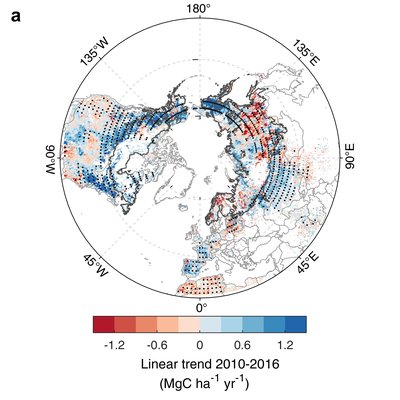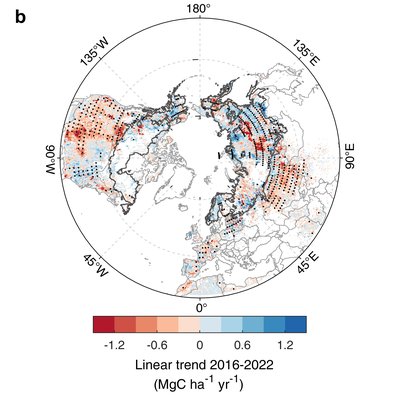Forests spanning Earth’s northern hemisphere, once reliable carbon sinks, have been losing more carbon than they absorb since 2016. A recently published study by the environmental physician Xiaojun Li and colleagues (2025) attribute this decline to increasing droughts, wildfires and forest degradation from other environmental disturbances, such as logging, insect outbreaks, and permafrost thaw.
The analysis covered northern ecosystems (≥30°N), including boreal and temperate forests and tundra regions across Russia, Europe and North America, from 2010 to 2022. It identified 2016 as the turning point at which living biomass carbon stocks began to decline. Although northern ecosystems recorded a net increase in carbon stocks in living biomass over the entire period from 2010 to 2022, between 2016 and 2022, these ecosystems lost an average of 0.20 petagrams of carbon (PgC) per year – roughly equal to the annual emissions of over 160 million cars. Temperate biomes experienced the largest losses, at 0.26 PgC per year. This corresponds to an annual gross loss of four per cent of the carbon stored in living biomass over this period, while boreal forests saw smaller but significant declines. The analysis reveals significant year-on-year variations primarily due to extreme events. Severe drought and record temperatures for instance resulted in carbon loss accelerating significantly during 2022. This led to slower plant growth and reduced the capacity of forests, grasslands, and soils to absorb carbon dioxide from the atmosphere. The study highlights the vulnerability of northern ecosystems to climate extremes and underscores the need to continue strengthening scientific understanding and further quantify the fate of carbon and represent these dynamics in climate models to better predict and anticipate the consequences of future change.

“It is difficult to say whether the negative trend seen during our seven-year observation period merely reflects changes occurring roughly every decade or indicates a turning point with consequences for the long-term dynamics of the northern ecosystems,” says Philippe Ciais, researcher at Laboratoire des Sciences du Climat et de l'Environnement, and Co-author of this study. “The significant losses in living biomass that we observed during this period show that the role of this important carbon sink needs to be reassessed in light of ongoing global warming.”
Detailed maps of carbon stocks made possible with satellite data
The study was conducted as part of the European Space Agency's Climate Change Initiative (ESA CCI) “REgional Carbon Cycle Assessment and Processes” (RECCAP-2) project which focuses on improving knowledge of the carbon cycle. The aim of this study was to better understand the changes in carbon storage within northern ecosystems. The measured above-ground biomass, namely tree trunks and branches, is considered an Essential Climate Variable by the Global Climate Observing System due to its crucial role in carbon storage and emissions. Its global record of distribution and density is derived from various satellite missions.

To monitor changes in vegetation carbon stocks, the research team used L-band Vegetation Optical Depth (L-VOD) data from ESA's Soil Moisture and Ocean Salinity (SMOS) satellite. Unlike traditional methods, L-VOD provides consistent and timely updates, making it a valuable tool for understanding long-term trends. This technology provides a unique ability to monitor above-ground biomass carbon on an annual basis, as it can penetrate dense forest canopies to detect changes in stems, branches and leaves with high precision.
Head of ESA’s Actionable Climate Information section, Clement Albergel, notes, “Satellite data, such as those from ESA's SMOS mission, are changing the way we monitor and understand the carbon cycle. Observation-based evidence from space, enables researchers to better quantify carbon storage and improve models used to predict the evolution of the carbon cycle and knock-on impact to the climate system.”
To estimate the total amount of biomass carbon, the study combined above-ground biomass with below-ground biomass, which were calculated using the root-to-shoot ratios recommended by the Intergovernmental Panel on Climate Change (IPCC). These ratios describe how plants allocate biomass between their roots and above-ground parts. A higher ratio indicates greater investment in roots, which can reflect environmental stressors such as drought or nutrient deficiencies. This comprehensive approach allowed the researchers to produce detailed maps of biomass carbon stocks in northern ecosystems from 2010 to 2022.
This study highlights the importance of long-term, validated data in revealing trends that would otherwise go unnoticed. As northern forests come under increasing pressure, the insights provided by ESA's Climate Change Initiative and its projects are essential for improving climate models and helping policymakers protect these vital ecosystems. As a major research and development effort, ESA's Climate Change Initiative generates decades-long, global satellite data records of Essential Climate Variables (ECVs), which are key to understanding the Earth's climate system. These records enable comprehensive climate monitoring and underpin the models and services that support informed decision-making worldwide.
Reference: Li, X., Ciais, P., Fensholt, R. et al. Large live biomass carbon losses from droughts in the northern temperate ecosystems during 2016-2022. Nat Commun 16, 4980 (2025). https://doi.org/10.1038/s41467-025-59999-2

